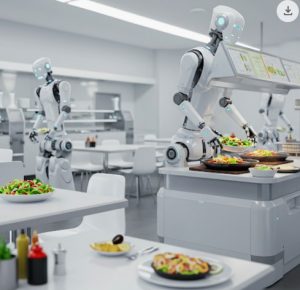
Imagine walking into a restaurant where robots glide between tables, arms deftly flipping burgers, and AI systems curate your meal—all while human staff focus on hospitality. This isn’t science fiction; it’s the reality reshaping the food industry. As labor shortages and rising costs plague restaurants, automation has emerged as a lifeline. While fully autonomous eateries remain rare, pioneers are blending robotics with human ingenuity to redefine dining.
Trailblazers in Automation
A handful of innovators are leading the charge:
- Spyce (acquired by Sweetgreen): Founded by MIT engineers, this Boston-based spot used a robotic kitchen to craft grain bowls in minutes. Though phased out post-acquisition, its hybrid model—robots assembling meals, humans adding artisanal touches—inspired a wave of imitators.
- CaliBurger & Flippy: Partnering with Miso Robotics, CaliBurger employs Flippy, an AI-powered robotic arm that grills burgers and fries with eerie precision. The result? Consistent quality and fewer burns for human coworkers.
- Haidilao Hot Pot: In China, robot servers deliver dishes to tables, while AI recommends personalized broths. Humans still cook, but automation handles the grunt work.
- Creator (San Francisco): A $6 million robot here crafts gourmet burgers from scratch—grinding meat, toasting buns, and layering toppings—while staff oversee the high-tech ballet.
The Tech Behind the Magic
Autonomous dining relies on cutting-edge tools:
- AI Vision Systems: Cameras and sensors guide robots to flip patties without splattering grease or undercooking.
- Collaborative Robots (Cobots): Machines like Bear Robotics’ Servi ferry food to tables, dodging chairs and toddlers with ease.
- Cloud Kitchens: Off-site hubs like Nala Robotics deploy AI chefs to cook everything from curries to pad Thai for delivery apps.
Why Fully Automated Restaurants Are Still Rare
Despite progress, most concepts blend bots and humans. Why?
- Cost Barriers: A single robot can cost 30,000–30,000–150,000, with maintenance fees piling up.
- Regulatory Hurdles: Health codes often mandate human oversight for safety checks.
- The Human Touch: Diners still crave interaction—a friendly face, a joke, or a personalized recommendation.
Glimpses of a Fully Automated Future
A few ventures dare to eliminate humans entirely:
- Eatsa (defunct): This quinoa-focused spot let customers order via iPad and grab meals from digital cubbies. It shuttered due to high costs but proved automation’s allure.
- Frobot: Miami’s 24/7 frozen yogurt kiosk uses robots to mix flavors and toppings—no staff needed.
- Piestro: Launching in 2024, this autonomous pizza machine promises pies in 3 minutes, no human hands involved.
What’s Next?
By 2025, expect hybrid models to dominate. Robots will handle repetitive tasks (chopping, frying, delivering), while humans focus on creativity and customer care. Niche spaces—airports, college campuses—may embrace full automation for speed and convenience. Startups like Hyper Robotics (sushi bots) and Keenon (serving bots in 40+ countries) are already scaling.
For entrepreneurs, the recipe is clear:
- Start small with delivery or cleaning bots to cut labor costs.
- Target high-traffic areas (malls, transit hubs) where speed trumps ambiance.
- Partner with firms like Miso Robotics or Richtech to share R&D burdens.
The kitchen of the future isn’t just coming—it’s already here, one automated burger flip at a time. 🤖🍟